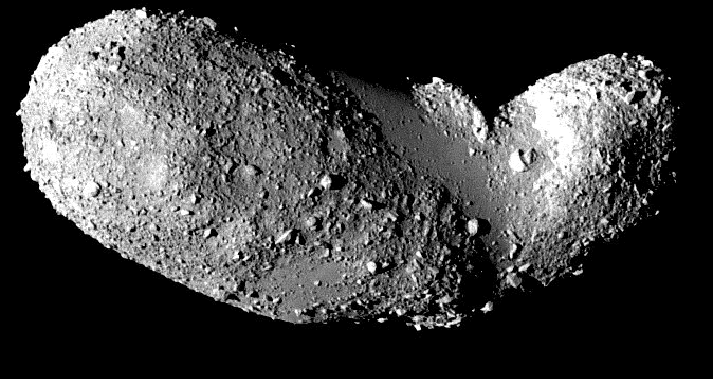About a decade ago, we were surprised to discover that there's a fair amount of water on the surface of the Moon. Given that the Moon has no atmosphere and receives enough solar radiation to boil any water off, how that water got there wasn't clear. One of the explanations offered at the time was that solar wind sends a steady stream of protons out in the Solar System, and these protons could interact with lunar material to produce water.
Fast-forward a decade and we now have asteroid samples brought back to Earth by two different probes. Working with some of the material obtained by Japan's Hayabusa mission, researchers have found a thin, water-rich layer is present there, too, consistent with being put in place by the solar wind. The researchers behind the finding suggest that this means many Solar System bodies are likely to be fairly water-rich—a reservoir that could have made a big contribution to Earth's oceans.
Only skin deep
The asteroid 25143 Itokawa was the target of the first successful sample-return mission to an asteroid. Itokawa is what's called a "rubble pile," as it's made up of small fragments produced by collisions among asteroids and then slowly gathered together by gravity. Asteroids like this may have fragmented and re-formed multiple times over their history, and they could be composed of portions of more than one body.
A large, international research team took some of the fragments returned to Earth and subjected them to a variety of imaging techniques. The researchers determined that the outermost 40 to 180 nanometers of rock were transformed by their time in space due to bombardment by high-energy radiation. This region also had elevated levels of water and hydroxyl ions (OH-). This finding is consistent with the idea that the water was produced by the interaction between protons in the solar wind and silicate-rich materials in the rocks themselves.
Based on the typical depth of the material that was transformed by the solar wind, the researchers could calculate the amount of water in particles of different sizes. And while there's very little here individually, Itokawa has a lot of small, dust-like particles, which have a high surface area relative to their volume. So it all adds up to an estimated 20 liters of water in every cubic meter of the powdery regolith on the asteroid.
This high fraction is possible because all of the dust on Itokawa has circulated into and out of space over the course of the rubble pile's collision-filled past. So even if something is now buried in the interior, it almost certainly was exposed to the solar wind in the past.
Isotope oddity
Total up all the rubble piles wandering the Solar System, as well as the upper surfaces of the airless bodies, and there's a remarkable amount of water held by the ostensibly dry bodies. That's potentially interesting, should humanity ever manage to make its way out of the Solar System for extended exploration.
But the water also has implications for the Earth's present and past. Most of the Earth's water is thought to have arrived after the massive collision that fragmented a proto-Earth and produced the Moon. Over time, small bodies fell to Earth and brought water with them to create our oceans.
But if we go by the elements in our crust, the bodies that arrived on Earth have a different ratio of hydrogen isotopes from the waters in our ocean. Put differently, the oceans have water that (in isotope terms) is somewhat lighter than the water found in the asteroids that have a composition similar to Earth's. The solar wind, in contrast, has hydrogen isotopes that are overall lighter than what we see in our oceans. So the researchers propose that the solar wind has indirectly helped fill our planet's oceans by producing water on dust particles that eventually fell to Earth.
Finally, the researchers note that the process isn't done. At present, an estimated 30,000 tonnes of dust grains fall from space each year. And these tiny particles will have the highest amount of water per mass of anything exposed to the solar wind. That's still not much water in a given year, but it starts to add up over the billions of years Earth has been around.
Nature Astronomy, 2021. DOI: 10.1038/s41550-021-01487-w (About DOIs).



3175x175(CURRENT).thumb.jpg.b05acc060982b36f5891ba728e6d953c.jpg)

Recommended Comments
Join the conversation
You can post now and register later. If you have an account, sign in now to post with your account.
Note: Your post will require moderator approval before it will be visible.